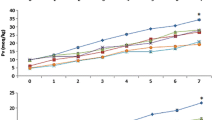Abstract
Oxidation stability of essential oils isolated from different herbs and spices was observed during 10 weeks at 10 °C. The progression in hydroperoxides which was exhibited by the increase in peroxide values (p < 0.05) was observed in all essential oils with the increase in shelf life. Amongst all tested essential oils, EC showed the highest preventive capacity against lipid oxidation. Similarly, elevated levels of thiobarbituric acid reactive substances and p-anisidine of essential oils were observed when shelf duration progressed (p < 0.05). The essential oil of EC also showed the highest antioxidative potential during the study and a negative correlation with the lipid oxidation studies was observed. As lipid-based foods are vulnerable to oxidation which leaves them off-odour and simultaneously decrease in nutritional attributes. Therefore, the application of natural antioxidants such as essential oils can be a potent substitute to reduce the rate of lipid oxidation and rancidity of food items during prolonged shelf life. Prior to addition of these antioxidant rich essential oils, it is necessary to assess the oxidation behavior of these essences to determine their antiperoxidative mechanism when incorporated in food matrices.




Similar content being viewed by others
References
S. Burt, Int. J. Food Microbiol. 94(3), 223–253 (2004)
C. Turek, F.C., Compr. Rev. Food Sci. Food Saf. 12(1), 40–53 (2013)
G. Ruberto, M.T. Baratta, Food Chem. 69(2), 167–174 (2000)
M. Saito, H. Sakagami, S. Fujisawa, Anticancer Res. 23(6C), 4693–4701 (2003)
M.A. Meier, J.O. Metzger, U.S. Schubert, Chem. Soc. Rev. 36(11), 1788–1802 (2007)
B. Halliwell, S. Chirico, Am. J. Clin. Nutr. 57(5), 715S-724S (1993)
C.A. Reilly, S.D. Aust, Curr. Protoc. Toxicol. 2.4, 2.4.1–2.4.13 (2001)
A. Moayedi, K. Rezaei, S. Moini, B. Keshavarz, J. Am. Oil Chem. Soc. 88(4), 503–508 (2011)
B. Min, D. Ahn, Food Sci. Biotechnol. 14(1), 152–163 (2005)
S. Cheikh-Rouhou, S. Besbes, B. Hentati, C. Blecker, C. Deroanne, H. Attia, Food Chem. 101(2), 673–681 (2007)
T.A. Coll, G. Chaufan, L. Pérez-Tito, M.R. Ventureira, C. Sobarzo, M. Carmen Ríos de Molina, E. Cebral, Mol. Reprod. Dev. 84(10), 1086–1099 (2017)
E. Kulås, R.G. Ackman, J. Agric. Food Chem. 49(4), 1724–1729 (2001)
W.T. Wai, B. Saad, B.P. Lim, Food Chem. 113(1), 285–290 (2009)
J. Han, X. Weng, K. Bi, Food Chem. 106(1), 2–10 (2008)
S. Takeungwongtrakul, S. Benjakul, Eur. J. Lipid Sci. Technol. 116(8), 987–995 (2014)
M.M. Özcan, Ö Erel, E.E. Herken, J. Med. Food 12(1), 198–202 (2009)
Q.D. Do, A.E. Angkawijaya, P.L. Tran-Nguyen, L.H. Huynh, F.E. Soetaredjo, S. Ismadji, Y.-H. Ju, J. Food Drug Anal. 22(3), 296–302 (2014)
M. Chaijan, S. Benjakul, W. Visessanguan, C. Faustman, Food Chem. 99(1), 83–91 (2006)
A. Papastergiadis, E. Mubiru, H. Van Langenhove, B. De Meulenaer, J. Agric. Food Chem. 60(38), 9589–9594 (2012)
Y. Zhang, L. Yang, Y. Zu, X. Chen, F. Wang, F. Liu, Food Chem. 118(3), 656–662 (2010)
M. Laguerre, J. Lecomte, P. Villeneuve, Prog. Lipid Res. 46(5), 244–282 (2007)
R. Steele, Understanding and Measuring the Shelf-Life of Food, ed. by J.W. Irwin, N. Hedges. Woodhead Publishing Series in Food Science, Technology and Nutrition (R Unilever and D, Sharnbrook, 2004), p. 289
S.-J. Kim, A.R. Cho, J. Han, Food Cont. 29(1), 112–120 (2013)
W. Zheng, S.Y. Wang, J. Agric. Food Chem. 49(11), 5165–5170 (2001)
Acknowledgements
I would like to thank Miss Tahira Mohsin Ali for basically perusing the manuscript and worthwhile discussions. This research did not receive any specific grant from funding agencies in the public, commercial, or not-for-profit sectors.
Author information
Authors and Affiliations
Corresponding author
Ethics declarations
Conflict of interest
The Authors declare that they have no conflict of interest.
Rights and permissions
About this article
Cite this article
Naeem, A., Abbas, T., Ali, T.M. et al. Effect of storage on oxidation stability of essential oils derived from culinary herbs and spices. Food Measure 12, 877–883 (2018). https://doi.org/10.1007/s11694-017-9702-3
Received:
Accepted:
Published:
Issue Date:
DOI: https://doi.org/10.1007/s11694-017-9702-3




